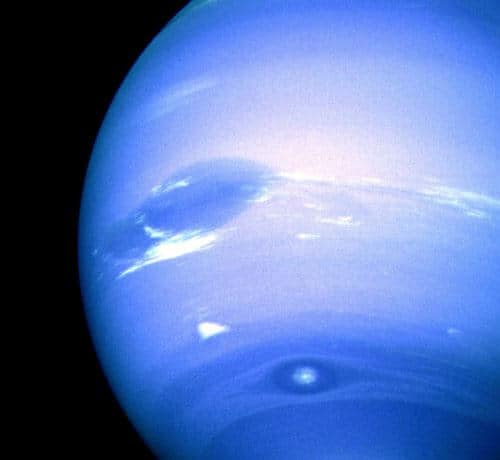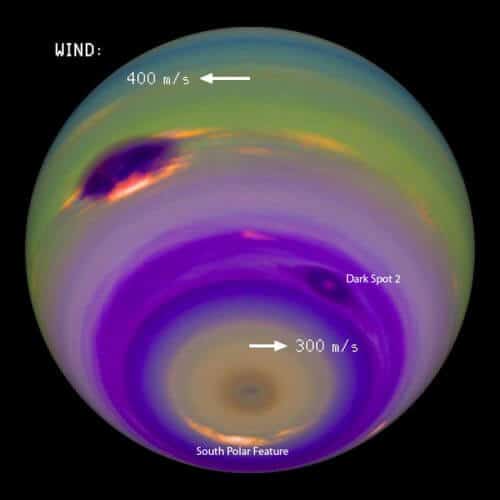Neptune, or Rahab in Hebrew, is the eighth planet from the Sun. Below are findings from recent years on the ice giant.

1. In the infrared observations made in July 2007, a bright spot was noticed at the South Pole. This spot was first observed by Voyager 2 when it passed by the planet and has since been seen in several telescopic observations. What was seen in July 2007 surprised the researchers. During these observations the spot split in two and after a few days the two parts reconnected. These appear to be methane clouds caught in a powerful vortex by winds. This estimate was reached based on a similar phenomenon observed at Saturn's south pole by the Cassini spacecraft. Hurricanes are thousands of kilometers wide. Neptune's spots correspond to cloud shapes formed by methane rising upwards and condensing (condensation). Neptune has methane rain.
2. In an examination of 500 archival photographs of Neptune, two formations were discovered in the atmosphere that rotate around themselves at a speed 5 times greater than the hexagonal formation at the north pole of Saturn and are also more stable in this movement. One was named South Polar Feature and the other was named South Polar Wave. These are eddies moving in the atmosphere similar to Jupiter's red spot. The person who discovered these formations followed photographs taken over 20 years. It is believed that these formations are related to Neptune's interior in some way that is not yet clear.

3. Observations from the Hubble Space Telescope on June 25-26.6.2011, 2, clouds are seen at high altitude in the Northern Hemisphere and the Southern Hemisphere. The clouds are made of methane crystals. More clouds are visible than what was observed several years before when most of the clouds were in the southern hemisphere. In this observation these clouds are moving towards the northern hemisphere. Right now, it's early summer in the southern hemisphere and winter in the northern hemisphere. In the Northern Hemisphere, a dark and thin strip is visible that was observed at the bottom of the Southern Hemisphere, which was probably created due to a decrease in the amount of haze in the atmosphere. The strip was first observed by Voyager 1989 in XNUMX and is probably related to the circulation created by high winds in this area.
4. Researchers have confirmed the presence of a black vortex moving along the atmosphere following a series of photographs taken by the Hubble Space Telescope in June 2016. This is the first vortex observed since 1994. It is a high pressure system accompanied by bright clouds. It is believed that these clouds were formed as a result of the eddy patch pushing air circulating around it higher and causing the gas to freeze into methane ice crystals. Dark eddies move through the atmosphere like lens-shaped icebergs and the accompanying clouds resemble orographic clouds that look like pancakes above mountains on Earth. Previous studies have shown that Neptune's eddies are long-lived. The last eddies observed come in a variety of sizes and shapes and recently appeared to be unstable, moving north and south and short-lived.

5. This year a new storm was discovered that was 9000 km in size. The storm is bright and found in low latitudes near the equator. Clear clouds have never been observed in this place. The brightness of the storm was seen between 25.6 and 2.7. It has nothing to do with eddies such as the storm observed on Saturn in 2010. This storm indicates sharp changes in the dynamics of Neptune's atmosphere. This is probably seasonal weather that can occur once every few decades.
See more on the subject on the science website:
- Neptune's dark spot
- Israeli scientists have calculated the gravitational "fingerprint" of the wind patterns on the planets Uranus and Neptune
- Neptune - Rahav has completed one lap since it was discovered
- Rahab Diamonds
Footnotes
- Paragraph 1 – Extraterrestrial hurricane discovered at Neptune's south pole", 19.3.2010"
- Paragraph 2 – Daniel Stolte –“Clocking Neptune's Spin”, January 29.6.2011, XNUMX
- Paragraph 3 – Neptune completes first orbit since discovery in 1846", 13.7.2011"
- Paragraph 4 – Brooks Hays –“Hubble locates new dark spots on Neptune”, January 23.6.2016, XNUMX
- Paragraph 5 – Twilight observation reveals huge storm in Neptune", 4.8.2017"
